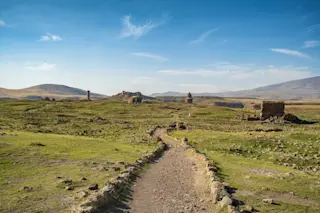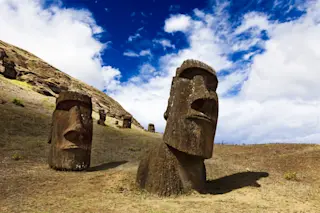More than 6,000 years ago, on a bleak island in the Norwegian Arctic, Stone Age fishermen carved some of the oldest images of boats.
With the icy Arctic Ocean to their north and the Norwegian Sea to their west, Scandinavians have been known as hardy seafarers since at least the eighth century, when the Vikings first went marauding. But it now seems that the roots of the Scandinavian naval tradition go back much further--to more than six millennia ago. On an island off the coast of northernmost Norway, 250 miles above the Arctic Circle, archeologists have uncovered the most northerly collection of rock art yet known: carved images of Stone Age humans and animals, and Europe’s oldest images of boats.
Archeologist Anders Hesjedal and his colleagues from Norway’s Tromsø Museum announced the results of their excavation last year. At Slettnes on the island of Sørøya, Hesjedal’s team found a scattering of small boulders bearing more than a hundred sparrow-size carvings of animals--reindeer, birds, elk, bear claws--and five images of boats. Each boat had a prow in the shape of an elk’s head, and humans could be seen either in or close to the vessels.
The archeologists know roughly how old the images are from the layer of gravel that had covered the boulders. The gravel layer, which is found all along the coast of Norway, was deposited some 6,000 years ago, after the last ice sheets of the Ice Age had melted and the sea had reached its highest level. The carvings must have been made after the boulders were uncovered by the retreating ice but before they were covered again by the water and gravel. The boulders were raised to their present high and dry position by the rebounding land: freed from the depressing weight of the ice sheet, it has been slowly rising for the past 9,000 years.
Hesjedal thus estimates that the Sørøya images were carved between 6,000 and 9,000 years ago. That makes them the oldest known boat images in Europe and among the oldest in the world. (The boat drawers of Sørøya were certainly not the first boat builders, however; Australia was settled as early as 37,000 years ago by people who must have arrived in boats.)
Who were the early inhabitants of Sørøya? The answer is not clear. Ten thousand years ago, as the ice sheet covering Scandinavia began to shrink, northern Norway is thought to have been colonized from two directions: from the east, by hunters from the Russian steppes who were pursuing migrating game such as reindeer, and whose rock carvings of reindeer have been found not far from Sørøya on the Norwegian mainland; and from the south, by people who made their way up Norway’s ice-free west coast. At the moment there is no way of telling which direction the Sørøyans came from--or whether it was both south and east.
Certainly they were accomplished sailors, because their settlements have been found on islands even farther from the coast than Sørøya. And surely, says Hesjedal, they could not have survived on the occasional reindeer; they must have eaten fish and sea mammals, both of which are plentiful in the rich, Gulf Stream-warmed waters off northern Norway. Curiously, though, apart from two murky drawings that may represent whales, no sea creatures are depicted in the rock carvings from Sørøya.
Until this discovery, the predominant theory about northern rock art was that it represented a Stone Age menu, a list of the foods people ate, says Hesjedal. Yet we don’t find those sea-based species in this art. Instead we find land mammals such as bear and elk, which were not an important part of the diet. That’s why we think of the rock art as metaphors, symbols of something else, like totems. Indeed, some of the boats in the Sørøya drawings have reindeer in them, which suggests to Hesjedal that the artists were depicting a fantasy world--inspired, perhaps, by having come into contact with an inland community of reindeer hunters.
Hesjedal and his colleagues have found far more than rock carvings on Sørøya: scattered pieces of red ocher that might once have been used to color the carvings, remains of turf houses from later settlements, and arrowheads that are even older than the art. On this small place, says Hesjedal, we have documented continuous settlement during the past 10,000 years. This is a unique situation. It makes us able to study in great detail the changes that took place over a very long span of time.














